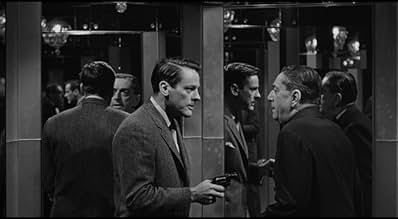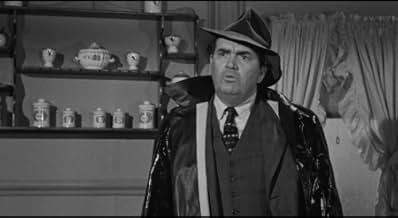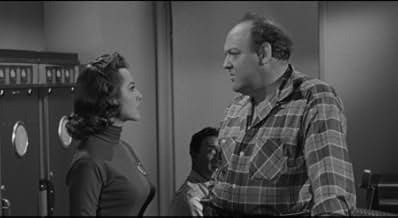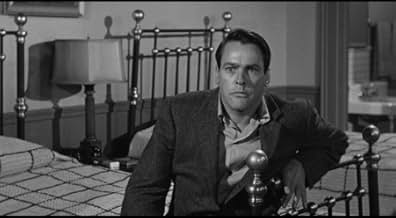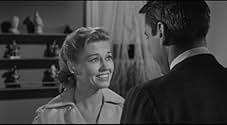CALIFICACIÓN DE IMDb
6.4/10
1.4 k
TU CALIFICACIÓN
Un músico de Nueva Orleans tiene una pesadilla en la que mata a un hombre en una casa extraña, pero sospecha que realmente sucedió.Un músico de Nueva Orleans tiene una pesadilla en la que mata a un hombre en una casa extraña, pero sospecha que realmente sucedió.Un músico de Nueva Orleans tiene una pesadilla en la que mata a un hombre en una casa extraña, pero sospecha que realmente sucedió.
- Dirección
- Guionistas
- Elenco
Ralph Brooks
- Oscar - the Bartender
- (sin créditos)
Jack Chefe
- Nightclub Waiter
- (sin créditos)
John Mitchum
- Onlooker at Stan's Suicide Attempt
- (sin créditos)
Cosmo Sardo
- Nightclub Patron
- (sin créditos)
- Dirección
- Guionistas
- Todo el elenco y el equipo
- Producción, taquilla y más en IMDbPro
Opiniones destacadas
Maxwell Shea remade his own film; the cheap Noir thriller "Fear in the Night" as 1956's "Nightmare" with a bigger budget and an A-list cast, yet the film follows the formers structure so closely you wonder what was the point. The two films are basically the same movie yet where they differ "Fear in the Night" comes out the superior, its hokey plot felt more at home with its low-budget and it was nicely complimented by an effective dark atmosphere, also the films conclusion and hallucination/dream scenes were sharper and more creatively shot . The one thing "Nightmare" has over the original is in the cast, 'Noir' staple and the always great Edward G Robinson, takes the role of the protagonist cop brother in-law (which was fairly flat in the original) and injects it with the warmth and vitality that is expected from him. Kevin Mcarthy has played the 'average man pushed to hysteria' role before but for good reason; he does it well, his performance is preferable to Deforrest Kelly's big eye-balled take on the same character. Even though its neck and neck with the original "Nightmare" comes out short, which doesn't make it a bad film, I just wouldn't recommend it if you've seen the original, but if you haven't there are some cheap B-movie thrills to be fond in the A-list surroundings.
This One has an Interesting Pedigree.
It is a Remake of a Film-Noir, Fear in the Night (1946) from the same Director, the Prolific (mostly screenplays) Maxwell Shane. Everybody Endlessly compares the two Movies,
This is a Distinctive Noir, at the End of the Cycle and it is Remarkable because it includes almost every Film-Noir Trope starting with the Title. Obsessive Fans of the Genre could make a List.
The least Impressive thing about "Nightmare" is the Print. TCM, a stickler for finding the Best Available, showed a very Unimpressive Version that was Weak all around. The Contrast is "Grayish" and the Look is very Flat. That Visual Disappointment Aside, the Film reminds of the Great Style that was all but Forgotten by 1956.
Seemingly Filmed on a Very Low Budget, it still manages to Conjure Up the Atmosphere of True Film-Noir. The On-Location Footage on the Streets and Bayou are "Nightmarish". The Film feels Odd and Off-Beat adding to the Enjoyment.
The Cast lead by Edward G. Robinson and Kevin Mccarthy give the Movie Gravitas and the Story, by Cornell Woolrich, is Rich with Mysterious Happenings and Dreamlike Displays.
If every Reviewer on Earth hasn't Spoiled the Ending You will Undoubtedly have a Fun Time with this Mystery Movie.
Highly Recommended for Low-Budget Entertainment.
This 1956 Film-Noir shows just what Staying Power the Genre could Generate. The Conservative Fifties, with Very Few Exceptions, had Hollywood Capitulating to Government Gawking and Back-Room Intimidation and the Cynical and Edgy Film-Noir Genre was Relegated to Cheap Second Features and within a Year or two was Abandoned Altogether.
Making a Comeback about Later, as Neo-Noir, the Movies Started Experimenting with a Renewed Energy as things were Opening Up Culturally and the Art Form found that the Freedom to Express was again winning the Public's Imagination and Imagination is obviously one of the Ingredients in the Creative Process.
It is a Remake of a Film-Noir, Fear in the Night (1946) from the same Director, the Prolific (mostly screenplays) Maxwell Shane. Everybody Endlessly compares the two Movies,
This is a Distinctive Noir, at the End of the Cycle and it is Remarkable because it includes almost every Film-Noir Trope starting with the Title. Obsessive Fans of the Genre could make a List.
The least Impressive thing about "Nightmare" is the Print. TCM, a stickler for finding the Best Available, showed a very Unimpressive Version that was Weak all around. The Contrast is "Grayish" and the Look is very Flat. That Visual Disappointment Aside, the Film reminds of the Great Style that was all but Forgotten by 1956.
Seemingly Filmed on a Very Low Budget, it still manages to Conjure Up the Atmosphere of True Film-Noir. The On-Location Footage on the Streets and Bayou are "Nightmarish". The Film feels Odd and Off-Beat adding to the Enjoyment.
The Cast lead by Edward G. Robinson and Kevin Mccarthy give the Movie Gravitas and the Story, by Cornell Woolrich, is Rich with Mysterious Happenings and Dreamlike Displays.
If every Reviewer on Earth hasn't Spoiled the Ending You will Undoubtedly have a Fun Time with this Mystery Movie.
Highly Recommended for Low-Budget Entertainment.
This 1956 Film-Noir shows just what Staying Power the Genre could Generate. The Conservative Fifties, with Very Few Exceptions, had Hollywood Capitulating to Government Gawking and Back-Room Intimidation and the Cynical and Edgy Film-Noir Genre was Relegated to Cheap Second Features and within a Year or two was Abandoned Altogether.
Making a Comeback about Later, as Neo-Noir, the Movies Started Experimenting with a Renewed Energy as things were Opening Up Culturally and the Art Form found that the Freedom to Express was again winning the Public's Imagination and Imagination is obviously one of the Ingredients in the Creative Process.
I had a feeling of deja vu as I watched this, and I soon realized it was a remake of Fear in the Night, a 1947 film starring DeForrest Kelley.
This film stars Edward G. Robinson, Kevin McCarthy, Virginia Christine, Connie Russell.
A young New Orleans jazz musician Stan (McCarthy) dreams that he's involved in a murder. He wakes up holding a button, a key, and he has blood on him. He's convinced he committed murder without realizing it. He approaches his brother-in-law Rene (Robinson), a police detective, who brushes it off as a nightmare.
One day, while on a picnic, Stan, Rene, Rene's wife (Christine) and Stan's girlfriend Gina (Russell) are caught in a rainstorm. Without realizing how he knows, Stan directs them to a house. There's a mirrored room as in his dream, and the key fits a closet.
Rene realizes that somehow Stan was involved and accuses him of lying and demanding to know the whole story. Stan swears it was all a dream, and he doesn't know what happened. When the sheriff comes along and tells them there was a murder in the house, Rene wants more information, believing Stan is a killer.
Neat story by Cornell Woolrich, who wrote "Rear Window." Edward G. Robinson is great as always as a man determined to get to the bottom of the mystery.
Kevin McCarthy, who worked until he died at 96, is adorable in this.
Some fantastic singing by Connie Russell -- it's worth watching the film just to hear her -- in what would be her last film. After a long career on stage, films, and clubs on two continents, she retired when she became a mom.
Very entertaining. The end is wonderful, and really puts it a cut above "Fear in the Night."
This film stars Edward G. Robinson, Kevin McCarthy, Virginia Christine, Connie Russell.
A young New Orleans jazz musician Stan (McCarthy) dreams that he's involved in a murder. He wakes up holding a button, a key, and he has blood on him. He's convinced he committed murder without realizing it. He approaches his brother-in-law Rene (Robinson), a police detective, who brushes it off as a nightmare.
One day, while on a picnic, Stan, Rene, Rene's wife (Christine) and Stan's girlfriend Gina (Russell) are caught in a rainstorm. Without realizing how he knows, Stan directs them to a house. There's a mirrored room as in his dream, and the key fits a closet.
Rene realizes that somehow Stan was involved and accuses him of lying and demanding to know the whole story. Stan swears it was all a dream, and he doesn't know what happened. When the sheriff comes along and tells them there was a murder in the house, Rene wants more information, believing Stan is a killer.
Neat story by Cornell Woolrich, who wrote "Rear Window." Edward G. Robinson is great as always as a man determined to get to the bottom of the mystery.
Kevin McCarthy, who worked until he died at 96, is adorable in this.
Some fantastic singing by Connie Russell -- it's worth watching the film just to hear her -- in what would be her last film. After a long career on stage, films, and clubs on two continents, she retired when she became a mom.
Very entertaining. The end is wonderful, and really puts it a cut above "Fear in the Night."
Kevin McCarthy, a jazzman from New Orleans, has a nightmare. He dreams he was in a strange room and committed a murder, only to find out the next morning that there are clues he actually did it. Terrified, he goes to his brother-in-law (Edward G Robinson) to ask for help. Edward G doesn't believe him at first, but soon the evidence begins to pile up. The rest is too good to reveal. Kevin McCarthy's performance right on the heels of "Invasion of the Body Snatchers" is flawless - the terrified victim - again. Eddie G's character as the cynical, hard boiled homicide dick is one of his best. The story riveted me from start to finish and director Maxwell Shane set just the right tone. Watch for the final scenes in the mirrored room. The atmosphere shots of New Orleans in the 50's transports us back to another time. It's a mystery - a drama - a thriller. Do not miss it.
If you can get past the improbable key to the mystery, the rest of the movie has some good, strong points. The first twenty minutes plunge us into McCarthy's nightmarish events that may or may not have actually happened. We don't know for sure and neither does he, but there are the scratches on his arm. Did he kill those people or not. The surreal effects are impressively done.
McCarthy delivers a gripping performance, as good as Invasion of the Body Snatchers (also 1956), and much better than expected for a B-movie. In short, he makes us believe that his dilemma, however improbable, is real and not just a story construct. Without that intensity drawing us in, the movie would, I think, amount to little more than a mildly interesting walk-through.
The New Orleans locations provide a clever anchor to the real world, and a good setting for the colorful jazz scenes. However, a 63-year old Robinson is at least 10 years too old for the brother-in-law part even though he manages the cop role well. And can we really believe the chance occurrence onto the scene-of-the-crime mansion in all that unfamiliar backcountry. Unfortunately, the script requires more than just an ordinary suspension of disbelief. Too bad the script couldn't work in more bayou scenes. Those coming at the end are really creepy and nightmarish in their own right. Too bad also that the excellent McCarthy made so few films, preferring, I gather, stage productions instead. All in all, an interesting if regrettably flawed little movie.
McCarthy delivers a gripping performance, as good as Invasion of the Body Snatchers (also 1956), and much better than expected for a B-movie. In short, he makes us believe that his dilemma, however improbable, is real and not just a story construct. Without that intensity drawing us in, the movie would, I think, amount to little more than a mildly interesting walk-through.
The New Orleans locations provide a clever anchor to the real world, and a good setting for the colorful jazz scenes. However, a 63-year old Robinson is at least 10 years too old for the brother-in-law part even though he manages the cop role well. And can we really believe the chance occurrence onto the scene-of-the-crime mansion in all that unfamiliar backcountry. Unfortunately, the script requires more than just an ordinary suspension of disbelief. Too bad the script couldn't work in more bayou scenes. Those coming at the end are really creepy and nightmarish in their own right. Too bad also that the excellent McCarthy made so few films, preferring, I gather, stage productions instead. All in all, an interesting if regrettably flawed little movie.
¿Sabías que…?
- TriviaWhen Stan goes out walking the morning after his nightmare, he passes by a place with a sign that says "New Orleans' Most Famous Coffee Drinking Place." That would be the Morning Call Coffee Stand that was on Decatur Street in the French Quarter. Opened in 1870, it moved to Metairie in 1974.
- ErroresAccording to the elevator there are only 15 floors in the hotel, but the shot of the building from outside shows more than fifteen.
- Citas
[first lines]
Stan Grayson: At first, all I could see was this face, this beautiful babe's face, floating toward me. And in my head, was this slow, crazy melody - like a tune from another world. And then a I saw the room - a queer mirrored room. And somehow, I was inside of it. There was danger there. I knew that.
- ConexionesFeatured in Out of this World Super Shock Show (2007)
- Bandas sonorasWhat's Your Sad Story
Words and Music by Richard M. Sherman (as Dick Sherman)
Performed by Connie Russell / Billy May Orchestra
Selecciones populares
Inicia sesión para calificar y agrega a la lista de videos para obtener recomendaciones personalizadas
- How long is Nightmare?Con tecnología de Alexa
Detalles
- Tiempo de ejecución1 hora 29 minutos
- Color
Contribuir a esta página
Sugiere una edición o agrega el contenido que falta



